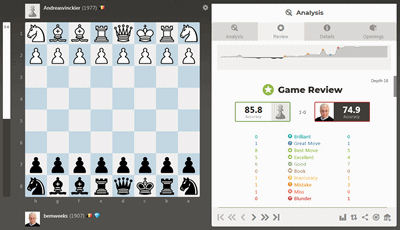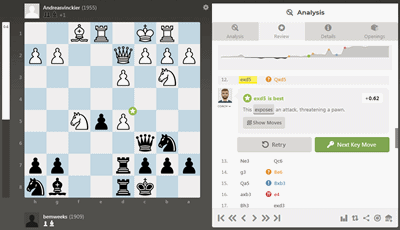The following diagram shows the start of the same game featured in the 'Tactical Error' post. There's more I can say about the look and feel of the 'Analysis' tool itself, but I'll save that for a series I'm doing on my main blog. The most recent post in that series was Chess.com's Game Review Tools PGN (February 2023).
Shown on the left is the start position for the game, 'SP350 NRKQRBBN'. On the right is a summary of the overall quality of the players' moves ('Brilliant', 'Great Move', ..., 'Blunder'). For example, the tool considers that both players made one 'Great Move'.

AV vs. bemweeks | Analysis
(chess.com)
The following table shows the tool's comments on the first 12 moves of the game (24 ply deep). I stopped the analysis when I reached the move where I committed the 'Tactical Error'.
| Move | Short |
Long |
|
|---|---|---|---|
| 1.e4 | is excellent | This prepares the bishop for development. This threatens to reveal an attack on a pawn. | +0.13 |
| 1...e5 | is good | This prepares your bishop for development. | +0.30 |
| 2.f4 | is excellent | This exposes an attack, threatening a pawn. | +0.27 |
| 2...Nb6 | is excellent | Your piece jumps in to protect a pawn! | +0.41 |
| 3.fxe5 | is best | Right on target. | +0.41 |
| 3...f6 | is an inaccuracy | You are threatening to attack a trapped rook. | +1.09 |
| 4.Nb3 | is a mistake | This loses a pawn. | +0.05 |
| 4...fxe5 | is best | That wins a free pawn! | +0.05 |
| 5.Ng3 | is excellent | One of the best moves. | -0.02 |
| 5...Qf6 | is best | You activate your queen by moving it off of its starting square. | -0.02 |
| 6.Be3 | is good | This moves the bishop to a better location, allowing it to control more squares. | -0.30 |
| is good | Your rooks can see each other now, allowing them to provide mutual defense. | +0.02 | |
| 7.d3 | is best | That's what I would have recommended. | +0.02 |
| 7...d5 | is best | You are threatening to kick a bishop. | +0.02 |
| 8.Qd2 | is an inaccuracy | This ignores a better way to develop a queen off its starting square. | -0.47 |
| 8...Qc6 | is good | You are threatening to kick a bishop. | -0.10 |
| 9.Bg5 | is good | This wins a tempo by threatening a rook and forcing it to move away. | -0.38 |
| 9...Be7 | is a mistake | You are threatening to win material. | +0.56 |
| 10.Bxe7 | is best | After all captures, this is an equal trade. | +0.56 |
| 10...Rxe7 | is best | You trade off equal material. | +0.56 |
| 11.Nf5 | is good | This attacks a rook, winning a tempo when it moves away. This threatens to fork pieces. | +0.27 |
| 11...Red7 | is good | You have now doubled your rooks, allowing them to team up to create threats. | +0.62 |
| 12.exd5 | is best | This exposes an attack, threatening a pawn. | +0.62 |
| 12...Qxd5 | is a mistake | You overlooked a better way to recapture a piece. | +1.63 |
There's much more I could say about the comments, but it would not be useful at this point. Here are a few comments that jumped off the screen at me.
-
8...Qc6;
'You are threatening to kick a Bishop.'
•
The move defends against a nasty x-ray threat.
-
9.Bg5;
'This wins a tempo by threatening a Rook and forcing it to move away.'
•
The move doesn't win a tempo, but it might lose a tempo by forcing the Rook to a better square.
- 9...Be7; 'Is a mistake. You are threatening to win material.' • It's a mistake to win material? Something does not compute here.
And so on. The long comments are generally lame and show little understanding of chess960 opening objectives. What happened in the fight for the center?
The most valuable part of the exercise is to see the change in evaluation from one move to the next. It reaffirms the severity of my mistake on the 12th move.

